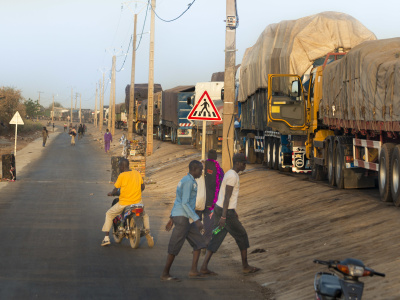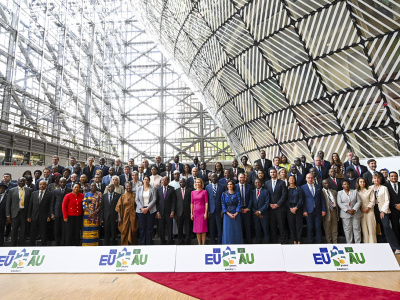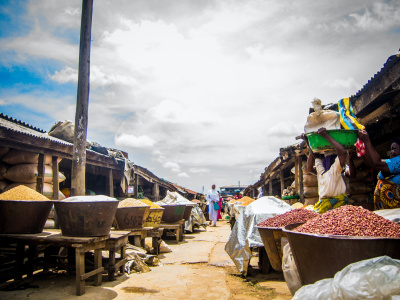
The EU’s Global Gateway: Groundbreaking initiative or smart rebranding?
Last week, the European Commission and the European External Action Service unveiled the EU's €300 billion ‘Global Gateway’ investment plan, intended as an alternative to China’s Belt and Road Initiative. Here’s what we have to say about the plan, the EU’s ambitions, the finances linked to it, and how it could and should add value to Africa’s infrastructure development.
San Bilal – In need of additional financial firepower
The Global Gateway is a most welcome initiative, but does the EU have the means to live up to its ambitions? Where is the additional financial firepower?
The proposal looks more like a smart rebranding of what the EU had planned to do already. The budget for the EU’s Neighbourhood, Development and International Cooperation Instrument (NDICI)-Global Europe for 2021-2027 has already been set, and its planning process is also underway. So is the EU mechanism to stimulate public and private investment abroad, under the enhanced European Fund for Sustainable Development (EFSD+). And while coordination among EU institutions and member states under the ‘Team Europe’ umbrella is a positive development, there are no additional financial commitments announced by EU member states under the Global Gateway.
If the EU wants to compete with China, it should identify new funding sources and make sure the European Investment Bank and other European public development banks and financial institutions can leverage more sustainable investment. The Global Gateway could provide a political push in this direction. But competing with China might not be of real added value for Europe. Adopting partnership approaches based on partner countries’ priorities and jointly mobilising investments may be a better way forward.
The real innovation in the Global Gateway would be the creation of the proposed European Export Credit Facility. It would benefit European exports, show the potential of synergising economic interests with sustainability and development ambitions, and help connect European financial institutions for development with European export credit and investment promotion agencies.
Alfonso Medinilla – Delivering a solid and credible offer
The launch of the Global Gateway comes mere days after the 2021 Forum on China-Africa Cooperation (FOCAC) in Dakar and its announcements on vaccines and trade. In recent years, the EU (and the US) geopolitical competition narrative has become increasingly explicit, but it has also somewhat lost track of the reality of Chinese and European investment, especially in Africa. Chinese investment today is faced with debt repayment problems, which is why we’re not seeing the same billions of dollars in infrastructure commitments that we saw in 2018.
China is not only much more risk averse in Africa, but is also taking its first steps towards greening external investment, not least in its pledge to stop financing coal projects overseas. With this in mind, the EU has an interest in shifting its narrative from trying to emulate or one-up China, and deliver an offer that is both solid and credible. This will in part depend on the EU’s ability to channel resources quickly and effectively to scale up (renewable) energy deployment in the coming years.
Poorva Karkare – The EU is selling, but who's buying?
One part of the story is how to package the Global Gateway, but another is whether what the EU has to offer meets a genuine demand. Here the story may be more mixed. While African countries do see value in engaging in policy dialogue with the EU (especially in the social sectors), and would welcome more of the direly-needed investments, they generally have a ‘wait and see’ approach to whether this new initiative will indeed respond to African needs and priorities of job creation, economic development, climate adaptation and so on.
On the one hand, there are issues around the EU’s comparative advantage in providing large-scale infrastructure. On the other hand, it has a greater advantage in areas such as ensuring the sustainability of such investments, soft infrastructure in terms of data protection and privacy laws, technology transfer and strengthening intellectual property rights in a way that is appropriate for the current development context in African countries. Support that takes these considerations into account can go a long way in bringing about inclusive development, something the EU has continuously stressed in its engagement with Africa.
Fabien Tondel – A building block for long-term political ambitions
To propose a meaningful and credible alternative to the Belt and Road Initiative, the EU should also frame Global Gateway infrastructure investments in terms of broader and longer-term political ambitions that appeal to its partners.
In Africa, Chinese investments in infrastructure (roads, railways, ports and so forth) have not only served to access African natural resources and markets for Chinese manufactured goods, but also to pursue a broader foreign policy directed at the continent, especially since the late 2000s. Investments in school and university buildings, stadiums, cultural centres and fibre-optic internet have also helped build China’s ‘political influence’ over African states and elites, increasing its ‘soft power’ in spite of the mixed development impacts of infrastructure projects and the dependencies they have led to.
The EU could use the Global Gateway as a building block towards a more balanced and inclusive political partnership with Africa. It should foster the active participation of African small and medium-sized enterprises and local communities who could translate enhanced connectivity into more inclusive and sustainable growth.
Pamella Eunice Ahairwe – Can Europe ensure more added value for Africa?
Another way for the Global Gateway to add value is to make sure its investments help strengthen Africa’s independence, given the EU’s objective of supporting human capital development, with a focus on skills and capabilities. Currently, Chinese investments seem to attract Chinese contractors with limited engagement of the African labour force, regardless of the existing high unemployment rate on the continent. China might have missed an opportunity to collaborate with Africa on skills development, but the EU should not do the same in its Global Gateway agenda. It should aim for a hands-on approach to building Africa’s capacity, for the continent to independently implement its infrastructure development projects in the future.
Therefore, the EU needs to ask itself some of the difficult questions that go beyond the political rhetoric of this initiative. Can the Global Gateway bridge the development gaps left out by the Belt and Road Initiative? Can it lessen the debt trap that African countries are currently experiencing and which may worsen during the COVID-19 economic recovery era? Can it, while working with the African Union as an equal partner, exploit potential co-benefits between infrastructure policies and other sectoral policies for the economic transformation of African economies?
All this calls for minimising tradeoffs to secure shared economic and social returns on infrastructure investments in a jointly developed model that is compatible with the current climate change ambitions of the two continental Unions.
Andrew Sherriff – Results count, not rhetoric
The idea has been there for a while, but the (re)packaging, marketing and branding as Global Gateway is new. Since 2019, the European Commission, the European External Action Service and EU delegations have focused on how to be more strategic when it comes to EU aid spending, an effort to provide direction to the EU’s new €79.5 billion NDICI-Global Europe budget for 2021-2027. It is this process rather than the latest announcement from Brussels on the Global Gateway that will influence where the EU puts its money in terms of tangible initiatives.
In the planning process (or so-called programming) of the NDICI-Global Europe, the EU is identifying – and will hopefully agree on with partner countries – priorities and spending in individual partner countries and regions. Digital, climate, health and education, all Global Gateway areas, will likely feature strongly in spending, as they have already been priorities of the NDICI-Global Europe programming process since 2020.
In 2022, the EU’s individual, country, regional and thematic multiannual indicative programmes will provide more detail on how it will follow through on its ambitions. Inevitably, there will be significant pressure on the EU to use the specific initiatives and projects to demonstrate the added value of the Global Gateway. Yet the EU will be judged on results, not the rhetorical repackaging of initiatives.
The views are those of the authors and not necessarily those of ECDPM.











